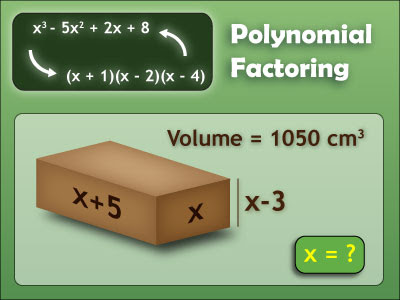Factoring polynomial is similar to factoring numbers, but you will be dealing with expressions instead of numbers. In order to factor a polynomial, you have to determine the polynomial that divides the original polynomial evenly.
 |
| Polynomial Factoring |
Different approaches are used to factor the polynomial; most common approaches are simple factoring, and factoring in pairs. In this article, you will find examples for these two approaches of polynomial factoring.
Simple Factoring
In simple factoring, you identify a common factor for the expression and place it before the parenthesis. What is a common factor? To know that, look at the example below:
5x + 60 = 5 (x) + 5(6) = 5 (x+12)
Now the common factor of the above expression is 5. To cross verify, multiply the factor with each term in the expression and ensure if you are getting the original polynomial back. For example,
5(x+6) = 5 multiplied with x + 5 multiplied with 12 = 5x + 60 (the original polynomial)
Factoring in Pairs
“Factoring in Pairs” is yet another factoring polynomials solver. This approach is used when you cannot find any common factor for the terms in the expression. In this approach, the expression is split into pairs of terms and then each pair will be factored separately. Here is an example:
Find the factors of ab-5b-2a+10.
This polynomial algebraic expression includes 2 variables namely a and b. There is no common factor for these 4 terms. In this case, take the first two terms and find a common factor. Similarly, take the last 2 terms and find a common factor, as shown below:
ab-5b-2a+10 = b (a-5) -2 (a-5) = (b-2) (a-5)
In the above step, the first two terms ab-5b are taken into consideration. Take the common factor out, it is b. Now it becomes b (a-5). Similarly take the next two terms -2a+10. The common factor is 2 here. When you put it as -2, the expression becomes -2 (a-5). Now the expression can be further simplified as (b-2) (a-5).
If the consecutive terms do not have any common factors, then you can rearrange the terms based on the commonality and then do the factoring.